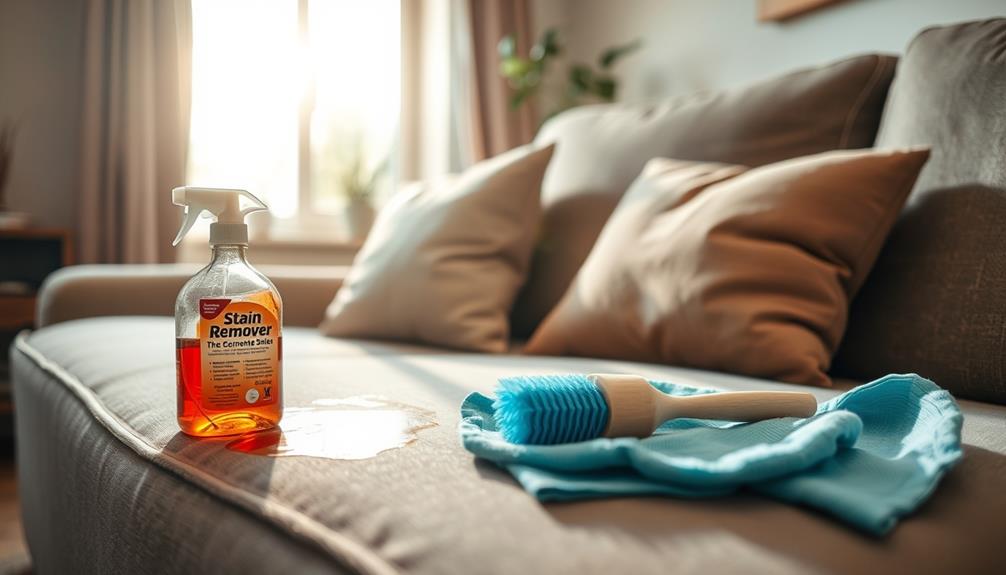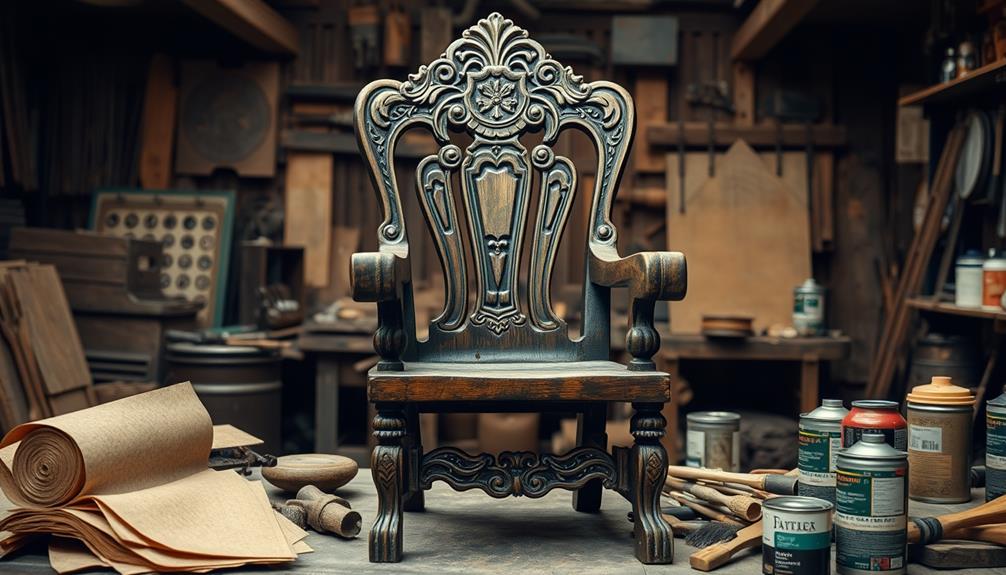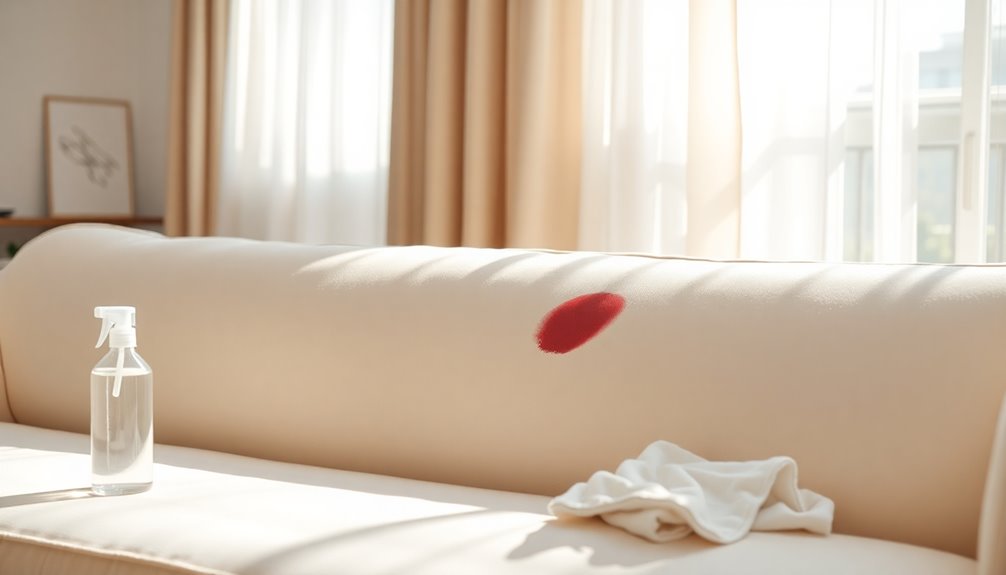You can effortlessly handle stains on your sofa at home with the correct methods and tools. Begin by checking the care tag for cleaning codes to identify safe techniques. For fresh stains, promptly blot with a clean cloth. Utilize mild detergent mixed with cold water for water-based stains or a vinegar solution for greasy marks. Craft a paste with baking soda for stubborn spots, allowing it to sit before vacuuming. Always test any cleaning solution on a hidden area first. These tips will help keep your sofa looking pristine, and there is more to discover about specific stains and preventive care. Additionally, exercise caution when using any cleaning solution on upholstered furniture, as some may potentially cause discoloration or fabric damage. When upholding the cleanliness of your sofa, also consider how it may affect other materials in your living space, such as staining wood furniture. By being mindful and utilizing the appropriate products and methods, you can ensure that your cleaning endeavors positively impact your entire home decor. This will aid in maintaining a cohesive and well-kept appearance throughout your living area.
Key Takeaways
- Quickly blot wet stains with a clean cloth to absorb moisture and prevent deeper penetration into the fabric.
- Check the care tag for cleaning codes (W, S, WS, X) to determine the safest cleaning method for your sofa.
- Use mild detergent mixed with cold water for water-based stains and a dish soap-vinegar solution for tougher, greasy stains.
- Create a baking soda paste for greasy stains; let it sit, then vacuum to remove residue and odors effectively.
- Always perform a spot test on an inconspicuous area before applying any cleaning solution to avoid damage.
Importance of Quick Action
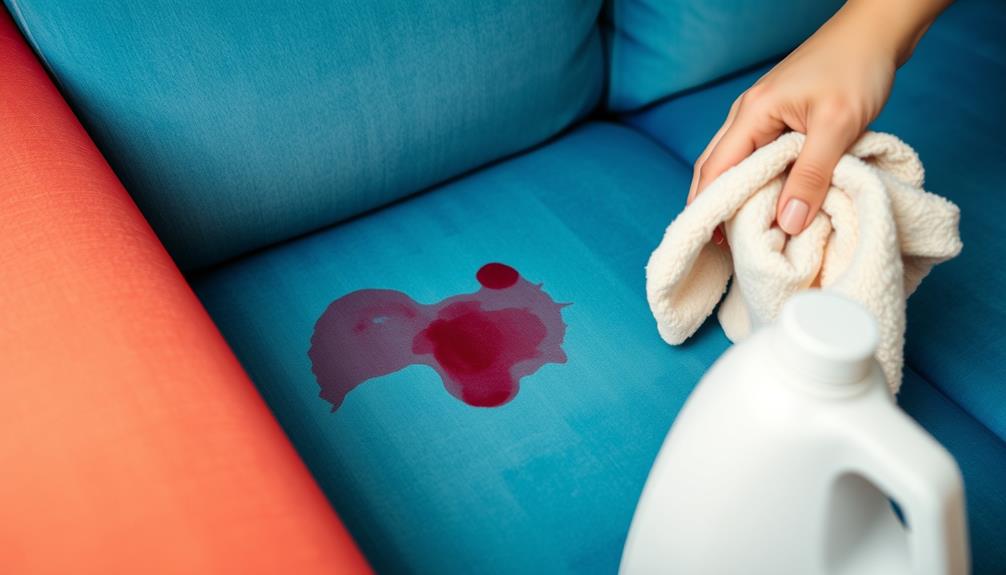
When you spill something on your sofa, quick action is essential. Stain removal is most effective when you act quickly, as stains can penetrate deeper into the fabric fibers over time. Immediate treatment not only increases the likelihood of complete stain removal but also prevents stubborn stains from forming.
If you let the spill sit, it bonds with the fabric, leading to permanent discoloration and potential damage. Using the right cleaning products right away can make a significant difference, just like how proper aftercare is vital for piercing hygiene.
For fresh stains, DIY methods can be effective. However, if the stain has set in or is older, you might need to call a professional upholstery cleaner. They've the expertise and tools to restore your clean upholstery to its original condition.
Addressing spills promptly preserves your sofa's appearance and extends its longevity. Remember, the longer you wait, the harder it becomes to remove the stain.
Preparing for Stain Removal
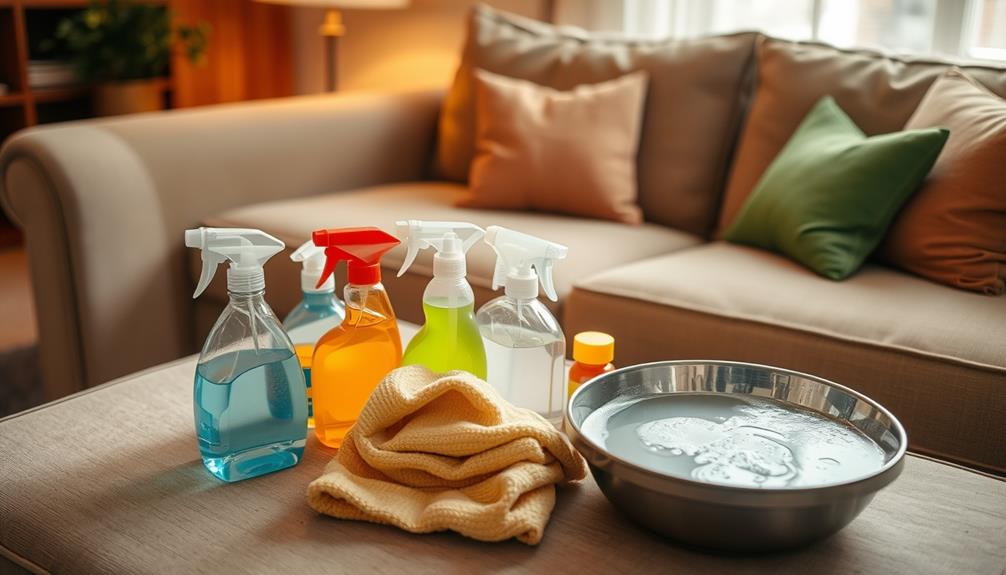
Preparing for stain removal involves several key steps that can make the process smoother and more effective.
First, check the care tag on your sofa for cleaning codes such as W, S, WS, or X. These codes help you determine the appropriate cleaning method for your upholstery type.
If you notice a wet stain, immediately blot the stain with a dry, absorbent towel to soak up excess liquid. For dry stains, scrape off any solids and vacuum the area to prevent further embedding into the fabric. Using a vacuum designed for superior dust removal can help guarantee that the area is thoroughly cleaned before treating the stain.
Before applying any cleaning solution, conduct a spot test on an inconspicuous area of your sofa to verify it won't cause discoloration or damage.
It's also vital to gather your essential cleaning supplies, like microfiber cloths, water, and mild detergents, so you're ready to address spills as they happen.
Finally, make sure your cleaning area is well-ventilated, especially when using solvents or strong cleaners, to promote faster drying and reduce inhalation of fumes.
Common Cleaning Solutions
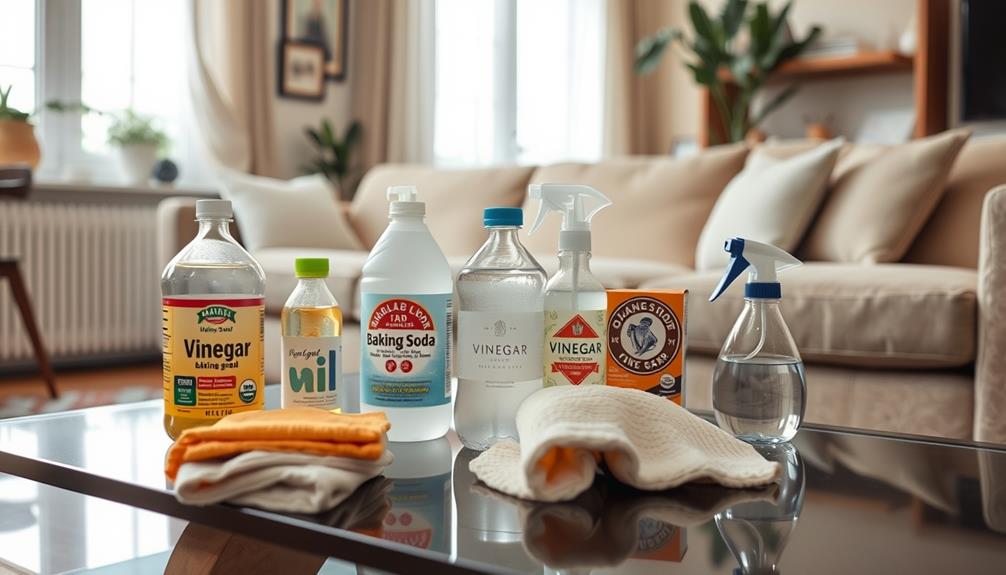
Cleaning solutions play an essential role in effectively tackling stains on your sofa. When it comes to upholstery cleaning, you've got several options at your disposal. Here's a quick guide to some common cleaning solutions that can help you remove stains effectively.
| Cleaning Solution | Best For |
|---|---|
| Dish Soap + White Vinegar + Warm Water | Tough stains like grease |
| Mild Detergent + Cold Water | Water-based stains (coffee, juice) |
| Baking Soda | Odor absorption & greasy stains |
For tough stains, mix dish soap, white vinegar, and warm water. Apply it directly to the stain and let it sit for about 10 minutes before you blot and remove it with a clean cloth. For water-based stains, a simple solution of mild detergent and cold water works wonders when blotted from the outside in.
If you're dealing with ink stains, solvent-based cleaners like rubbing alcohol can be effective, but remember to test them on a hidden area first. Finally, hydrogen peroxide can be a powerful stain remover for certain fabrics, so always perform a spot test to avoid bleaching.
Effective Cleaning Techniques
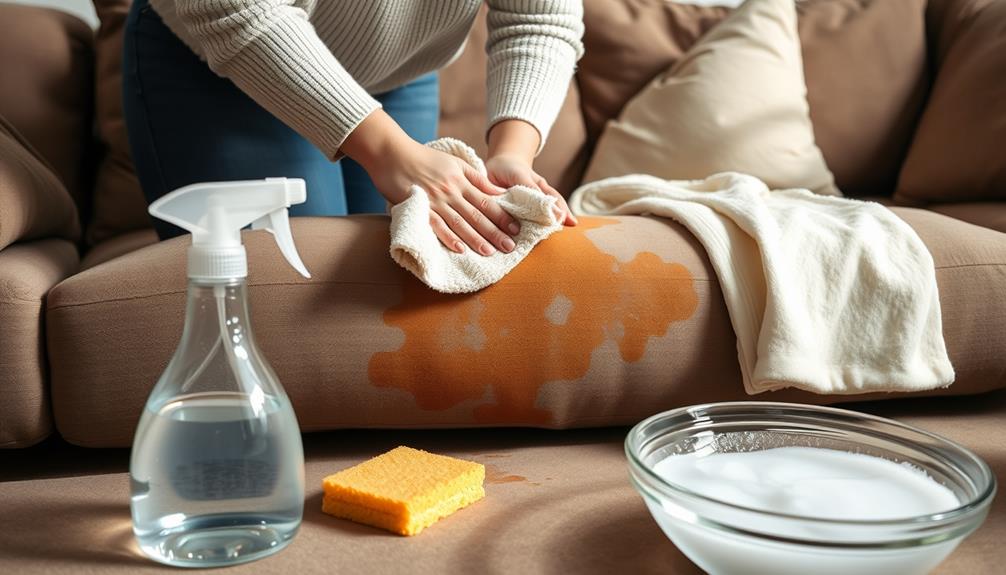
After identifying the right cleaning solutions for your sofa, it’s time to put them into practice with effective cleaning techniques. Start by vacuuming the upholstery to remove loose dirt and debris. This step is essential as it prevents further embedding of stains during the cleaning process. Next, dampen a clean cloth with the appropriate cleaning solution and gently blot the stained area, taking care not to rub it, which can spread the stain. If you’re dealing with particularly stubborn stains, it’s important to know how to clean blood stains safely; using cold water instead of hot can help prevent the stain from setting. Finish by allowing the upholstery to air dry completely to maintain its integrity and avoid any mildew.
Additionally, ensuring that your cleaning environment is free from airborne pollutants can enhance the overall cleanliness of your space, similar to how air purifiers maintain air quality.
For water-safe fabrics (coded W), mix a solution of mild dish soap and cool water. Blot the stain gently with a dry cloth, avoiding any rubbing that could spread the stain. Rinse the area with a damp cloth to remove soap residue.
For greasy stains, create a baking soda paste with water, apply it to the stain, and let it sit for 20 minutes before vacuuming to absorb any residue.
If you're dealing with stubborn stains on solvent-safe fabrics (coded S), use a dry-cleaning solvent. Always follow the manufacturer's instructions and test it on a hidden area first.
Different Types of Stains
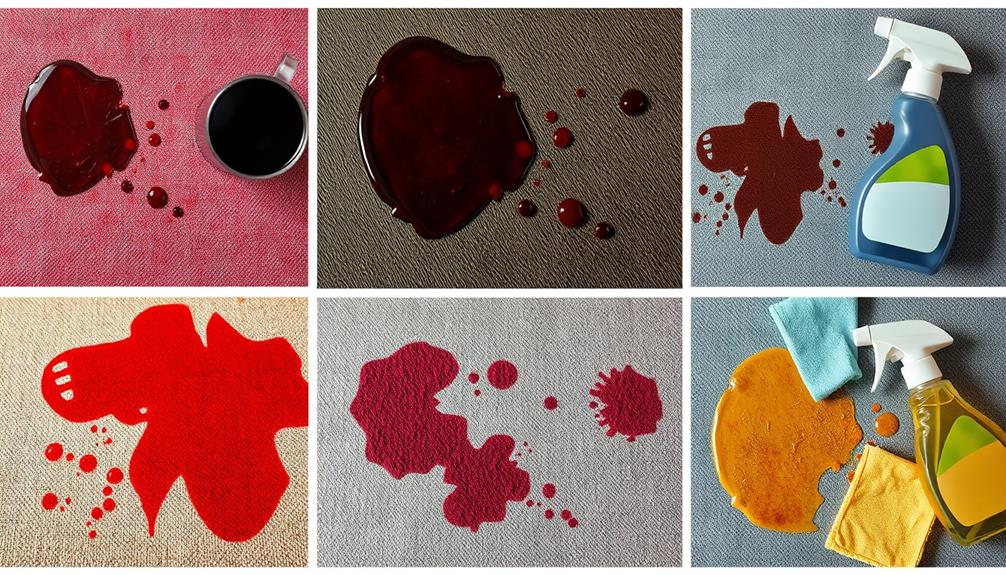
When it comes to sofa stains, knowing the type can make all the difference in how you tackle them.
You'll encounter water-based stains, grease stains, and even tricky ink stains, each requiring specific cleaning techniques.
For example, essential oils like eucalyptus oil can be useful for removing certain types of stains due to their cleansing properties.
Plus, the fabric of your sofa plays a vital role in determining the best approach for effective stain removal.
Common Stain Types
Sofas can easily fall victim to various types of stains, each requiring a different approach for effective removal. Water-based stains, like coffee, juice, and soda, are often easier to remove if you act quickly.
Use a cleaning combination of mild detergent and water to treat these stains, as they usually don't penetrate deeply into the fabric fibers. For additional support, consider the significance of selecting the right cleaning products for specific stains, as outlined in cold medications overview.
On the other hand, oil-based stains from cooking oil or grease need solvent-based cleaners for effective removal, since water can spread these stains further.
Ink stains can be particularly tricky; you'll need isopropyl rubbing alcohol and must blot rather than rub to prevent spreading the ink.
If you're dealing with pet urine stains, immediate action is essential. Blot the area right away and use enzyme-based cleaners that break down uric acid crystals to tackle both the stain and odor effectively.
Specific Cleaning Techniques
Effective cleaning techniques vary considerably depending on the type of stain you're dealing with. Here's a quick guide to help you tackle various stains on your sofa fabric:
| Stain Type | Cleaning Method |
|---|---|
| Pet Urine | Blot excess liquid and use enzyme-based cleaners. |
| Coffee | Absorb with a clean cloth, rinse with cold water, then treat with mild detergent or vinegar. |
| Oil-Based Paint | Use a water-free solvent like acetone, rinse with warm water if safe. |
| Grease | Sprinkle baking soda, let sit, vacuum, then use a water-based solution if needed. |
For ink stains, blot with isopropyl rubbing alcohol, then wash with dish detergent and warm water. Each method allows you to remove stains without compromising your sofa's integrity. If you're unsure or dealing with stubborn stains, don't hesitate to seek professional help or avoid dry cleaning solutions that might harm your upholstery. Remember, the quicker you act, the better your chances of successful stain removal!
Fabric Considerations
Understanding the fabric of your sofa is key to tackling stains effectively. Different types of stains require specific cleaning solutions, so knowing what you're up against makes a big difference.
The first step is to check the cleaning code on your upholstery. This will guide you on the safest methods to use, just as you'd with mechanic shops for fuel injection cleaning to guarantee your vehicle runs at peak performance.
Here are some common stain types and their solutions:
- Water-based stains: Coffee, juice, and soda can usually be treated with water-based stain removers.
- Oil-based stains: Grease or oil may need degreasing agents for proper removal.
- Pet urine: Enzyme-based cleaners are essential to break down uric acid crystals.
- Ink stains: Isopropyl rubbing alcohol works wonders for ink.
- Delicate fabrics: For stubborn stains on delicate materials, you might need to consult a professional.
When cleaning, always remove any loose particles first and remember to care not to rub the stain, which could spread it.
Professional Cleaning Options
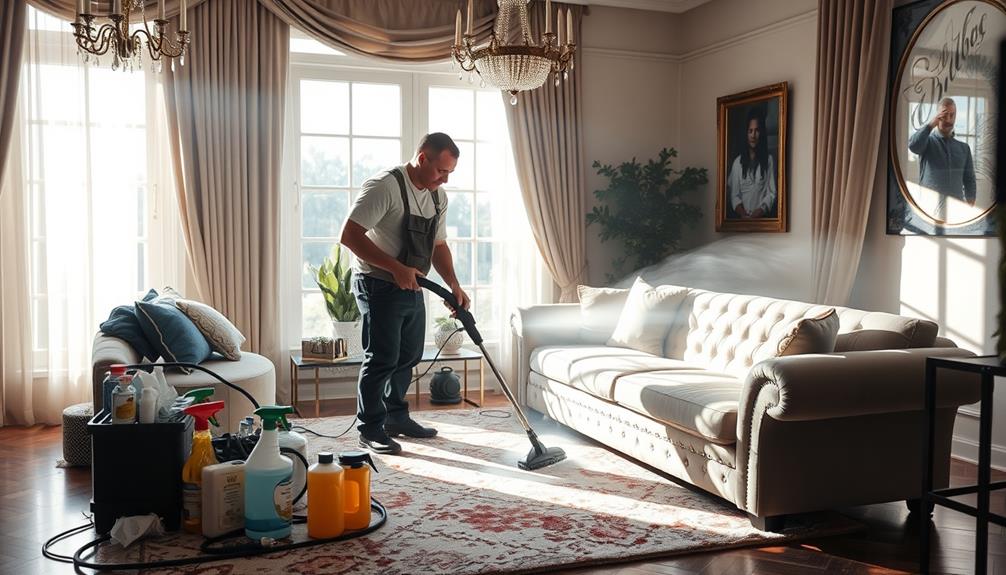
When it comes to tackling stubborn stains, many homeowners find that professional cleaning options can be a game-changer. Professional upholstery cleaning services not only save you time but also offer tailored solutions for tough stain removal based on fabric type and stain severity. If your DIY attempts have left behind deep-set stains, it might be time to call in the experts.
Here's a quick comparison of professional cleaning options:
| Service Type | Cost Range |
|---|---|
| Standard Upholstery | $100 – $300 |
| High-End Fabrics (e.g., suede) | Up to $500 |
| Customized Contracts | Varies based on needs |
Engaging professional cleaners is especially advisable for delicate upholstery or vintage pieces. They use specialized techniques that guarantee your fabric remains undamaged while effectively removing stains. Many companies even provide consultations to assess damage and suggest appropriate cleaning methods. So, if you're dealing with tough stains and unsure about the right approach, don't hesitate to seek professional cleaning assistance.
Preventative Measures

Regularly taking preventative measures can considerably reduce the chances of stains becoming a problem on your sofa. By implementing a few simple strategies, you can maintain the appearance of your furniture and make it easier to clean a couch when necessary.
For instance, creating a mood board that includes colors and fabrics can help you choose upholstery that isn't only stylish but also practical for your lifestyle.
Here are some effective preventative measures you should consider:
- Apply upholstery protection sprays to create a barrier against stains.
- Educate everyone in your household about spill prevention techniques.
- Keep a cleaning kit handy for quick access to stain removing solutions.
- Engage in frequent vacuuming to eliminate dust and crumbs that can embed into the upholstery.
- Use slipcovers for an additional layer of protection, making washing easy when needed.
Understanding Upholstery Tags
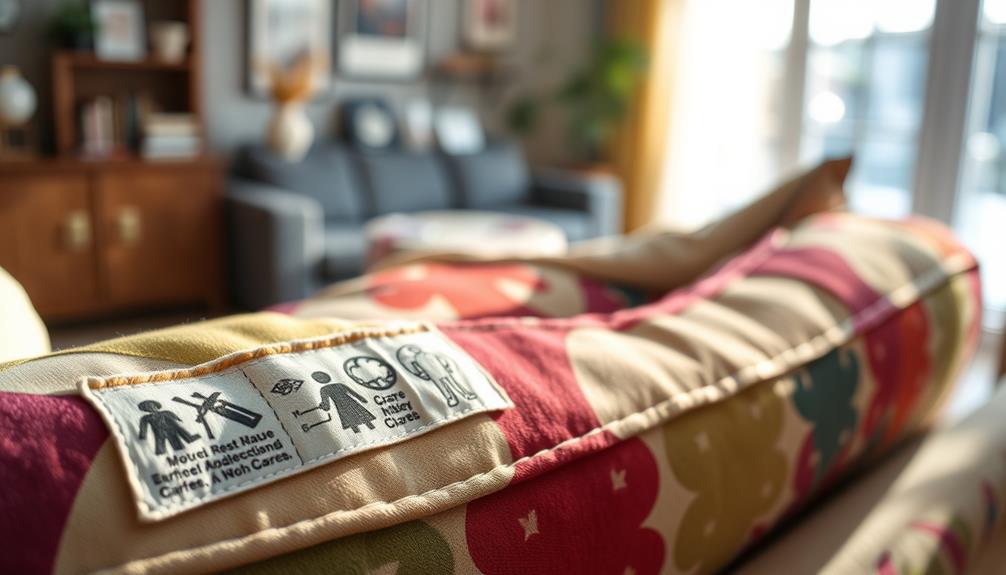
Proper care goes beyond just preventative measures; knowing how to clean your sofa effectively is equally important. One of the key elements in achieving this is understanding upholstery tags.
These tags provide essential cleaning codes that indicate the appropriate cleaning methods for different fabric types. For instance, a "W" means you can use water-based cleaners, while "S" indicates solvent-based options. If you see "WS," you can use both methods, and "X" means you should only vacuum.
Additionally, maintaining a secure home environment can help reduce the risk of stains caused by break-ins or accidents, as highlighted in discussions about the value of home security systems. Always check these tags, usually found under cushions or on the sofa's underside, before cleaning.
Ignoring the cleaning codes can lead to damage, ineffective cleaning, or even void your warranty. If you're dealing with vintage pieces that lack care tags, it's vital to perform spot tests on hidden areas first. This helps you avoid potential damage when cleaning.
Myths About Stain Removal
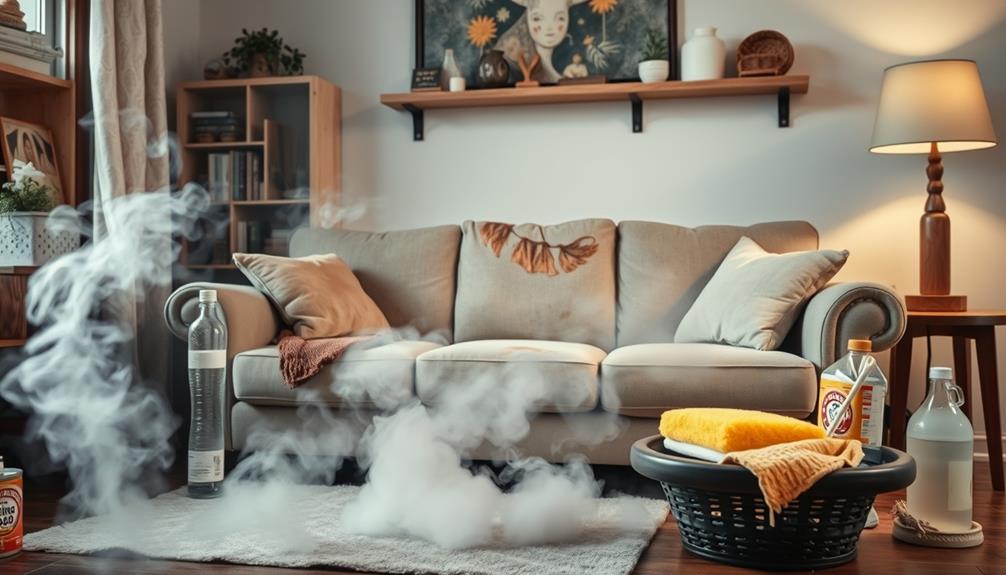
You might think that all stains can be easily tackled with just water, but that's not always the case. Many common myths can lead you to make mistakes that could damage your upholstery instead of helping it.
For instance, using excessive heat can set a stain rather than remove it, and certain household products mightn't be suitable for all fabric types. Knowing when to seek professional help can save your furniture and guarantee the best results.
Common Misconceptions Explained
Understanding the common misconceptions about stain removal can save you time and frustration when tackling spills on your sofa. Many people think they can handle every stain with DIY methods, but old stains often need professional attention for complete removal.
Additionally, just like with appliances, using the wrong cleaning method can lead to further damage or ineffective results, making it essential to understand the materials involved and their specific care requirements—similar to how appliance maintenance plans can extend the lifespan of your devices.
Here are some myths to be aware of:
- Water is always the best first response to stains.
- Bleach works universally for all stains.
- Any cleaning product can be used on upholstery.
- All stains require the same treatment approach.
- Dry cleaning is unnecessary for minor spills.
In reality, certain fabrics might react poorly to water, making things worse. Using bleach can damage your upholstery or change its color, so always check cleaning codes before applying anything.
Furthermore, different types of stains—like grease versus water-based—demand tailored cleaning methods for the best results. Ignoring upholstery care tags can lead to ineffective cleaning or fabric damage, which is the last thing you want when dealing with a stained area.
When to Seek Help
Stains can be stubborn, and knowing when to seek professional help is vital for effective removal. Many people think that all stains can be tackled with DIY methods, but that's simply not true. Old or set-in stains often require professional cleaning for complete removal, especially on delicate upholstery.
It's important to recognize that just as individuals with BPD experience emotional instability, some stains may also have complex characteristics that demand specialized treatment.
A common myth is that water is the best first response for all stains. Using water on certain fabrics can actually worsen the damage, particularly for those labeled as solvent-clean only.
Additionally, it's a misconception that bleach can eliminate all stains. In reality, bleach can ruin upholstery, causing discoloration or even creating more stains.
You should seek professional help if you've tried multiple DIY approaches without success, particularly for high-value fabrics. Always check the care tags on your sofa; ignoring cleaning codes can lead to ineffective cleaning or fabric damage.
Understanding these guidelines is essential to maintaining your upholstery. When in doubt, it's better to trust the experts who know how to handle specific stains and care for your sofa properly.
Don't risk further damage—sometimes, professional help is the best solution.
General Stain Removal Tips
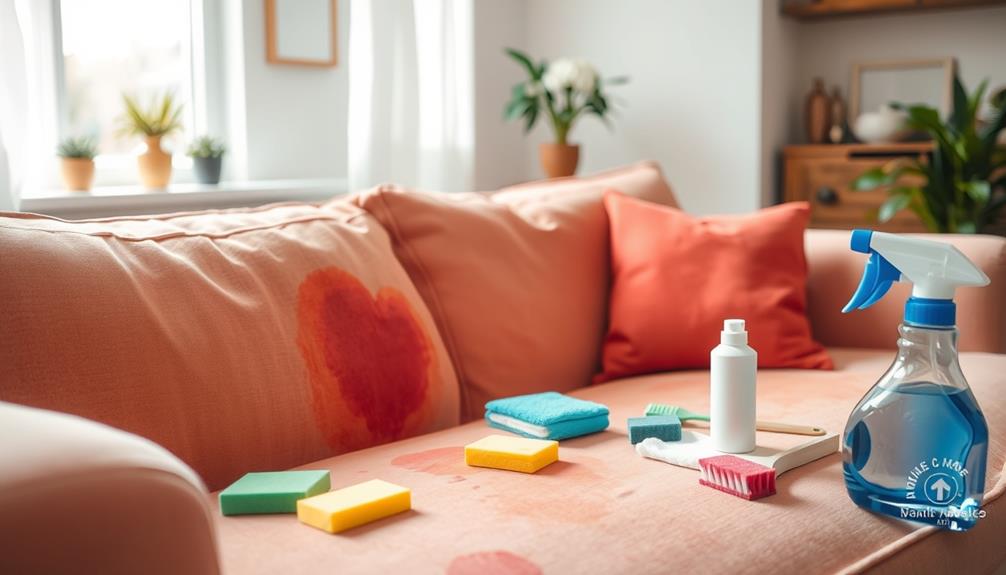
When it comes to tackling stains on your sofa, acting quickly can make a significant difference. Start by checking the couch cleaning code on the care tag to avoid damaging the fabric. If your sofa is water-safe (W or WS), you can use a mixture of soap and warm water for effective cleaning.
Here are some essential tips:
- Blot spills immediately with a clean white cloth to absorb excess liquid.
- Avoid rubbing, as it can spread the stain further.
- Apply your cleaning solution sparingly, working from the outer edge of the stain inward.
- For tougher stains, consider using a vinegar and water solution or rubbing alcohol, but always spot test first.
- Rinse the area with a damp cloth to remove any residue and guarantee the spot dries thoroughly.
If the stain persists after following these steps, don't hesitate to repeat the process or contact a professional upholstery cleaner for help.
Frequently Asked Questions
How Do You Get Stains Out of Couch Fabric?
To get stains out of couch fabric, start by checking the care tag. Blot the stain, apply a suitable cleaner, rinse thoroughly, and always test any solution in a hidden area first.
What Is a Homemade Stain Remover for Couches?
You can create a homemade stain remover by mixing equal parts of white vinegar and water. For tougher stains, combine dish soap with warm water and vinegar. Always test your solution on a hidden area first.
Can Old Stains Be Removed From Sofa?
Yes, old stains can be removed, but your success depends on how long they've set. Acting quickly improves your chances, so don't hesitate to try effective cleaning methods before considering professional help for stubborn marks.
How Do You Get Unknown Stains Out of a Couch?
To tackle unknown stains, start by vacuuming the area. Check the fabric's care tag, then use the appropriate cleaning solution. Blot the stain gently, and repeat if needed for stubborn marks.
Conclusion
In the battle against sofa stains, quick action is your trusty sword. By knowing your upholstery and using the right techniques, you can restore your couch to its former glory, like a knight polishing their armor. Remember, prevention is key—keep those pesky stains at bay. So, arm yourself with knowledge and don't let spills turn your living room into a medieval battlefield. With a little effort, your sofa can remain a welcoming haven for years to come.
